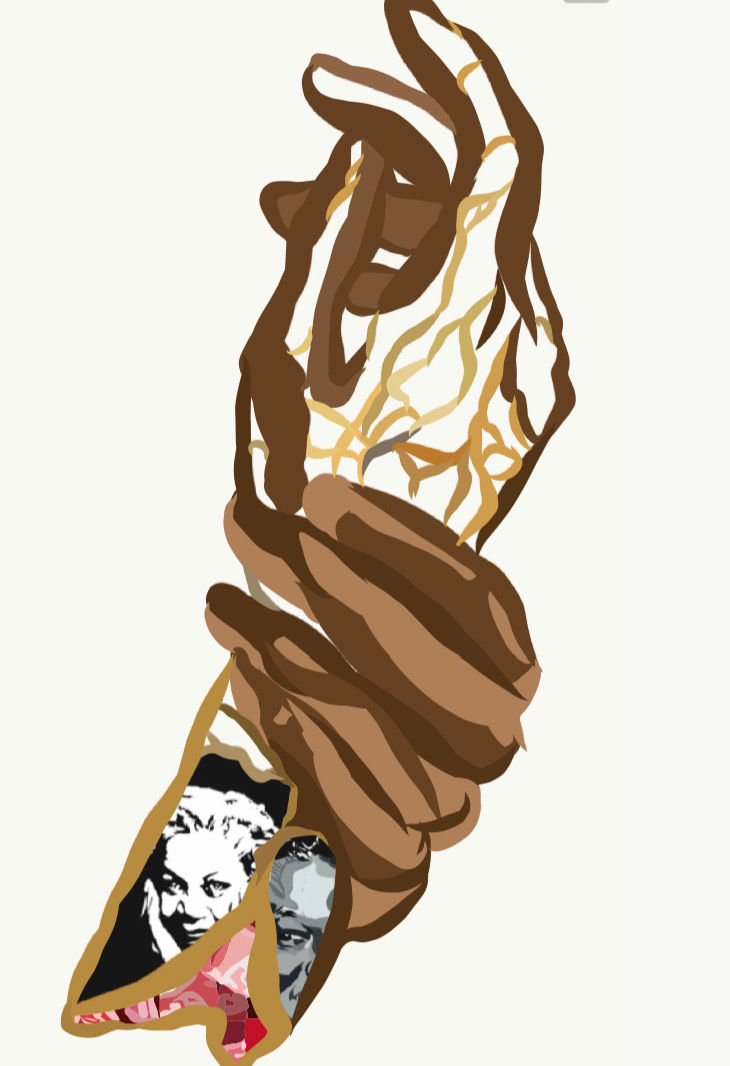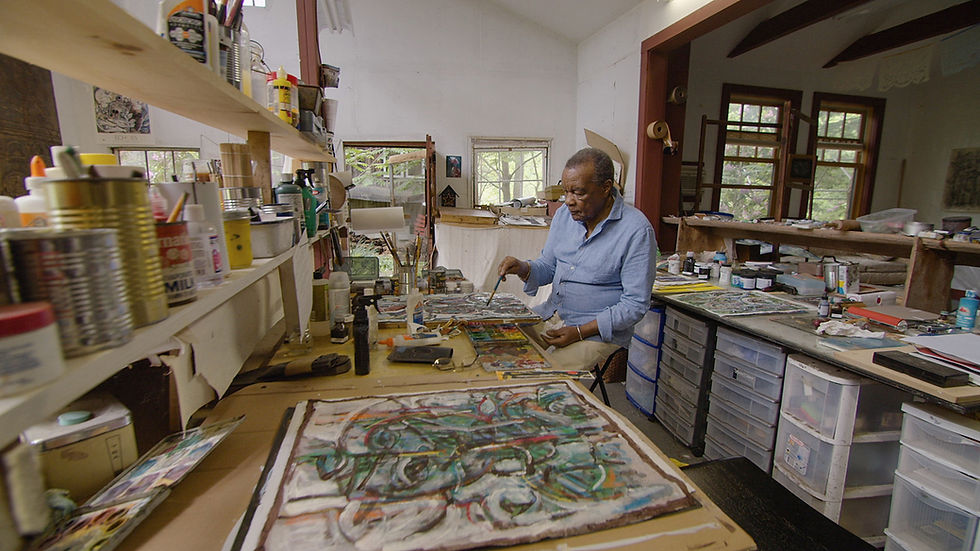Strong at the Broken Places
- frida@artyardbklyn.org

- Feb 5, 2021
- 6 min read
Updated: Feb 9, 2021
We have all been through the ringer of late. Sometimes it just feels overwhelming. This week in ART YARD Advanced Studio our very own Eden Moore spread her wings from her role of student into that of Teaching Artist with a poignant and powerful lesson titled Strong at the Broken Places.

In this session Eden had us use the materials of our choice to create pieces depicting a mix of various parts of our personal identities/communities pieced together into a single portrait.
Eden summarizes: “In teaching a beautiful introduction to the art of graffiti mastermind David Choe, and the Japanese philosophies of Wabi Sabi and Kintsugi – acknowledging the pain and flaws of the past to make something more perfect by repairing broken pottery and sculpture with literal gold - the whole class took the time to meditate and analyze their own imperfections, identities, and communities, expressed through portraits of their bodies and their different aspects of self. The results were diverse, colorful, multimedia expressions (some digital, some painted and one even sculpted from clay) that were beautiful and vulnerable and intensely creative.”


Pat writes: “Eden's lesson was amazing--I loved the concept and the technique! This is a self-portrait based on a selfie I took of myself during one of so very many Zoom sessions that I've been on this year. In the spirit of kintsugi, it's pieced together from fragments--here, a collage of things I had lying around that somehow represent communities that sustain me. The trees represent friends with whom I go on socially-distanced walks in nature areas. The Latin fragments represent my students (these are extra copies of handouts from class). The yellow parts are filler from an ad for a book about someone who goes diving with sharks (I have not read the book, but the fragments represent, in general, serendipitous things we find this year, and the ability of books to expand our horizons). The lenses of my glasses represent Boston and the night sky and everyone who embraces either or both of those (and yes, that's the Golden Record in the upper left). The piece from a wrapper of a ream of "Who But W. B. Mason" brand printer paper is in honor of my co-workers, who are an excellent team to go through a pandemic with. The Statue of Liberty represents everyone who's working for justice (it's from an old tax refund check that was just enough to buy the better part of a burrito). And, finally, the metallic Sharpie and glitter nail polish represent everyone at ART YARD Advanced Studio--what an adventurous, talented, and supportive group!”
Pat’s early progress of assembled collage materials:


Ed and Quentin also addressed the work and life balance.


Eden, Zeke (incorporating an actual scar), Marilyn ("In response to Eden’s wonderful lesson, I combined representations of my interests and activities including art, my garden and nature, travel, studying Italian, and dear friends as charms on a bracelet. Using watercolor, pen, and collage, I also added the element of Kintsugi that Eden presented by outlining everything with gold ink.") and Sarah (working in clay!) all focused on hand imagery.




Vera, Kevin (in progress), Wayne and Claude (in progress) all take portraiture in an exciting direction to rise to Eden’s challenge.




Ardelia and I both ventured into the ephemeral. Ardelia exploring her deepening spiritual growth and current artistic inquiry. I found inspiration in Remedios Varo’s painting La Llamada (The Call). Feeling that call to action to make art, develop artistic communities, teach, and -- well, to Hula Hoop! Also, in a nod to David Cho’s penchant for Superheroes, I elongated my glasses and placed around my neck a golden medallion a la Eartha Kitt’s Cat Woman.


Jenn explains her work: “I used a variety of materials for my image including markers and water soluble oil pastels. My piece ended up being a self-portrait with the tools that help me extend myself to my community. As an art therapist and artist, my hands, eyes, art supplies, and mind allow me to create a space that contains and supports individuals. This space allows me to serve others as well as serve myself and through the use of art materials, the bonds with my immediate community have strengthened.

Jacob depicts his top-three holidays to host and celebrate.

I am still waiting on images from August and Zahir, so please check back!
In other news:
Vera and Halli went to see exhibitions worth writing about and share their thoughts.
Vida Americana: Mexican Muralists 1925-2945 at the Whitney Museum
By Halli Beaudoin
It was months into an endless pandemic when I decided there was finally a museum exhibition too important not to see. So I double masked and got a timed ticket to visit the Whitney’s latest exhibition celebrating Mexican Muralists. The museum “recognized the clear urgency to exhibit works by artists of color”[1] and the result was Vida Americana.

Here were artists creating works intended to be seen in public spaces for the community at large and not just the rich. Paintings and drawings by the likes of legends like Diego Rivera, Frida Kahlo and Orozco captured a passion that screamed off the walls with a sense of timely frustration that moved everyone in the gallery.
“How can you walk through this and not feel like protesting for a better good?” I overheard a fellow museumgoer say.
The exhibition perfectly reflects our current climate and doesn’t shy away from showing works that provoke the viewer to questions the state of the world. Pieces like Elizabeth Catlett’s …and a special fear for my loved ones is from 1946 and yet captures themes of discrimination and fear for the fates of young black men that are still, horribly, applicable today.

Vida Americana recognized that many frescos are still installed in places like the Detroit Institute of Art, The New School in New York, and dozens of plazas in South America and therefore could not be displayed at the exhibition. The Whitney’s solution? A clean room where the murals were projected via 360 video feed. Viewers could be transported, seeing the art life size and exactly as the artists had intended it.
If you’re able to attend this powerful exhibition please do. It is a compelling reminder that our past may not be so far removed from the present.
[1] Vida Americana: Mexican Muralists Remake American Art, 1925-2945 at the Whitney Museum
Pleasure Garden: solo exhibition by Tourmaline at Chapter NY, 249 East Houston Street, NYC
By Vera Tineo
Tourmaline’s exhibition Pleasure Garden included a series of photos that express femme sexuality and power. This artist documents their existence as a black nonbinary person, capturing all the realness of their body and existence. I am particularly taken by the way Tourmaline engages with the viewer to make themselves super present in the space. In these powerful self-portraits I felt the gaze of the artist profoundly. The strong, unapologetic message being: I AM HERE. Also on view was a compelling video installation titled Salacia exploring the femme trans identity, imagination and the real struggles of life.

[From the exhibition press release] In this photograph, the artist, Tourmaline, a Black nonbinary trans person floats in midair with her knees slightly bent. She appears like a stylized astronaut mid-flight, floating through the Earth’s sky, rather than outer space.
Tourmaline is an artist, filmmaker, cultural producer, writer, and activist whose practice highlights the experiences of black, queer, and trans communities and their capacity to impact the world. By expanding the legacy of forgotten figures into our present moment and highlighting their minor yet impactful creative acts, she shifts our understanding of broader cultural histories and encourages a reconsideration of the mainstream contemporary narrative.
Ardelia gives us a heads up on what sounds like a fantastic documentary available to stream on HBO Max beginning February 9 – Black Art: In the Absence of Light. “The documentary opens with David C. Driskell’s appearance on The Today Show, where he discusses the exhibition with Tom Brokaw, who asks if “Two Centuries” has the effect of isolating Black artists from the mainstream, to which Driskell counters that it is the mainstream that has, in fact, isolated Black artists from art history.” (ARTnews, February 1, 2021)

Our friend, writer, artist and frequent ART YARD editor Lisa Peet forwarded an email she gets from Danny from Sketchbook Skool (click the link to sign up for his newsletter) titled 27 ways art can change your life. Lisa writes: “The three I copied down are 4, 8, and 9. I'm thinking about doing a sketchbook entry a day for each of them, though. For whatever reason, they just hit me in the right place today.”
(4) Value the journey, not just the destination. A life in art has no end goal. Just a series of wonderful adventures and discoveries. Picasso kept reinventing art well into his nineties and so could you.
(8) Find comfort in ambiguity. There is no right or wrong in making art. There is no step-by-step way to paint or draw. As you learn these lessons, you will feel freer and less confined. It’s all about discovery.
(9) It’s okay to ‘waste’ time. Our days are so scheduled, so packed with distractions. But we need to give our tired brains times to restore themselves. Stop, take ten minutes, and draw something simple every day.

These resonate for me particularly with ART YARD in mind:
Find Positivity: Art making lets you focus on the Now and live in this beautiful moment.
Artists Connect: As you connect with other artists, you will have a growing sense of belonging, of identity and of shared goals.
Stay strong!





Comments